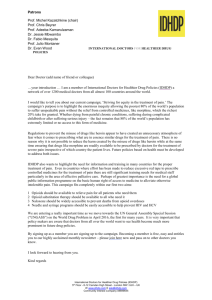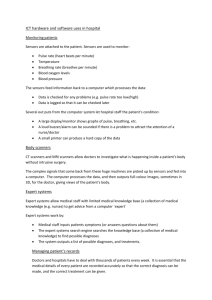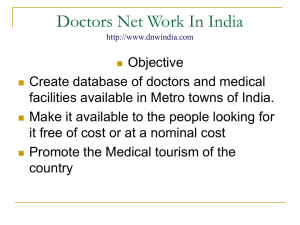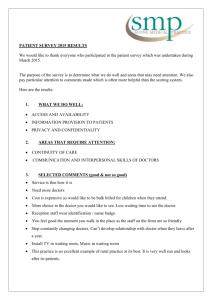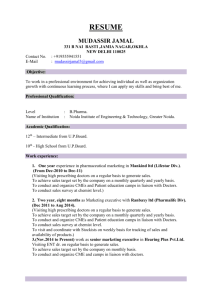Equality and Diversity Strategy 2014-2017
advertisement
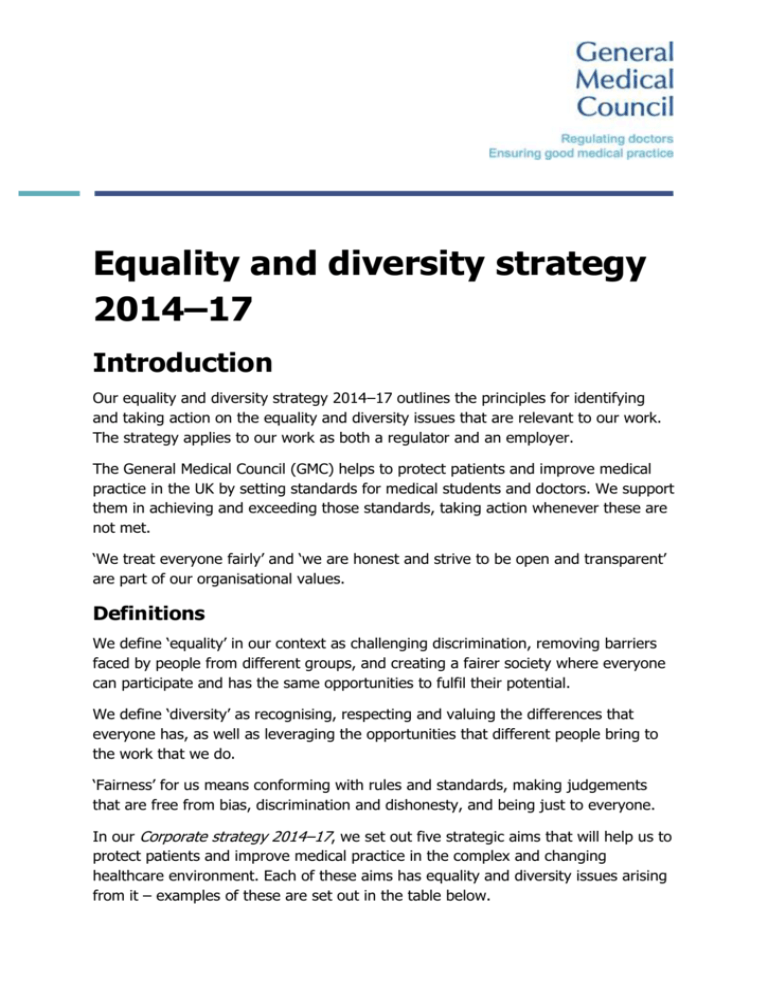
Equality and diversity strategy 2014–17 Introduction Our equality and diversity strategy 2014–17 outlines the principles for identifying and taking action on the equality and diversity issues that are relevant to our work. The strategy applies to our work as both a regulator and an employer. The General Medical Council (GMC) helps to protect patients and improve medical practice in the UK by setting standards for medical students and doctors. We support them in achieving and exceeding those standards, taking action whenever these are not met. ‘We treat everyone fairly’ and ‘we are honest and strive to be open and transparent’ are part of our organisational values. Definitions We define ‘equality’ in our context as challenging discrimination, removing barriers faced by people from different groups, and creating a fairer society where everyone can participate and has the same opportunities to fulfil their potential. We define ‘diversity’ as recognising, respecting and valuing the differences that everyone has, as well as leveraging the opportunities that different people bring to the work that we do. ‘Fairness’ for us means conforming with rules and standards, making judgements that are free from bias, discrimination and dishonesty, and being just to everyone. In our Corporate strategy 2014–17, we set out five strategic aims that will help us to protect patients and improve medical practice in the complex and changing healthcare environment. Each of these aims has equality and diversity issues arising from it – examples of these are set out in the table below. 2 Our strategic aim 2014–17 Equality and diversity considerations Make the best use of intelligence about doctors and the healthcare environment to ensure good standards and identify risks to patients. Mid Staffordshire and other inquiries confirm that there are groups of patients who are at increased risk of poor treatment from health professionals. Some of these patients are from groups that are protected1 by equality law. Some groups of doctors may need more support in delivering the best care to patients. There are certain characteristics that increase the risk of doctors being involved in our fitness to practise procedures. Help raise standards in medical education and practice. Continuing our efforts to ensure that all doctors, irrespective of their background, have the competence and skills to care for the diversity of the UK’s patient population, and understand the ethical issues that arise in practising in the UK. Improve the level of engagement and efficiency in the handling of complaints and concerns about patient safety. Including a diverse range of doctors in our local outreach and engagement to understand the profession and how we can support doctors more effectively in good practice. Doing more work to understand who brings concerns to us, recognising that some complainants will be people who share protected characteristics. Signposting complainants more effectively to the local procedures to deal with their concerns before they approach the GMC. Work more closely with doctors, medical students and patients on the frontline of care. Considering the needs and preferences of patients and doctors with protected characteristics as we seek new ways of making what we do more relevant to our key interest groups. Continuing to consider the impact of our activities The Equality Act 2010 specifies nine groups of individuals who have ‘protected characteristics’ that are covered by this legislation: age, disability, race, sex, gender reassignment, marriage and civil partnership, pregnancy and maternity, religion and belief, sexual orientation. 1 3 Our strategic aim 2014–17 Equality and diversity considerations on people with protected characteristics, including doctors, patients and the public. Continuing our work to ensure fair treatment of students and doctors with disabilities. Work better together to improve our overall effectiveness, our responsiveness and the delivery of our regulatory functions. Treating everyone with respect and continuing our work to be an employer of choice. Ensuring that our zero tolerance policies on bullying are adhered to. Aiming to achieve a diverse profile at senior levels, and to attract a diverse pool of applicants in our recruitment. Using our influence to encourage good practice on equality and diversity through our collaborative work with other organisations. In some instances this will be part of our work to comply with the provisions of the public sector equality duty. End of table, now use the down cursor key to go to the next section. Why equality and diversity matter to the GMC We believe that equality and diversity are integral to our work as a regulator and an employer for several reasons. Our ability to protect patients and improve standards of medical practice is reliant on maintaining the trust and confidence of all our interest groups and stakeholders. We want to understand and take account of the needs and expectations of the diverse groups of patients, doctors and others affected by our work. We want to continue to comply with equality and human rights legislation, and to be recognised as an organisation that aspires to high standards and good practice on the issues that arise from this – for example, around accessibility. The UK’s working population is diverse, and we want to have a workforce that reflects the diversity of the communities in which we operate at all levels. 4 What we know about the equality and diversity issues that arise from our work For patients and the public Mid Staffordshire and other inquiries have highlighted that some people are not receiving the standards of care they should expect from health professionals, including doctors. This includes some children and young people, older people, people with learning difficulties, and people with different communication needs. Our work with patients also confirms that there are substantial variations in the standards of care that some groups receive from their doctors – for example, lesbian, gay and bisexual people, some disabled people, and people at different stages of gender reassignment. Added to this, some groups protected by equality law have substantially poorer health than the general UK population, including travellers, and some black and minority ethnic people. We also know that some people from disadvantaged socioeconomic groups, for example, homeless people, can have difficulties accessing care. The reasons for these issues are complex and interrelated. Doctors’ behaviour can be an important contributing factor – for example, ageism may result in conditions like dementia being underdiagnosed and underreported. We meet with several organisations representing patients with protected characteristics. One of the questions they ask is: how are doctors equipped through their training to effectively treat a range of conditions, in a way that meets the communication and other needs of individual patients? They also ask us how this is reflected in the curricula that we approve. Another issue that comes up in our dialogue with patients is their need to receive care that is in line with their own beliefs and values, irrespective of their doctor’s religion or beliefs. We recognise that there are some patients for whom continuity of care will be particularly important – for example, patients receiving care from many different providers, and patients with capacity or communication difficulties. We know that some people with particular needs experience difficulties in raising their concerns locally or with us, and that we need to continue to work to make our processes fully accessible to anyone who needs to contact us. For doctors Some people face challenges in entering the medical profession. The selection procedures for studying medicine vary between medical schools, and our standards for students completing their medical degree may exclude some disabled people. 5 Our annual national training survey shows that people from lower socioeconomic backgrounds are proportionally underrepresented in medicine. Some groups of doctors in training (male doctors, black and minority ethnic doctors) also have lower pass rates in examinations and assessments. The law requires us to treat certain doctors differently. For example, we test the clinical and language skills of doctors who gained their primary medical qualification outside of the UK and the European Economic Area. We have pushed to get the law changed so that we can assess the language skills of all doctors who want to work in the UK. Doctors who haven’t completed GMC-approved specialist or GP training programmes can use alternative routes to show that they have the knowledge, skills and experience equivalent to doctors who have achieved a Certificate of Completion of Training (CCT) or who are practising as consultants in the NHS. But some doctors feel that the current options for assessing the equivalence of applicants are unfair. We make decisions that can substantially affect a doctor’s career and livelihood. Our fitness to practise procedures come under intense scrutiny for the profile of doctors involved. There are concerns that: some groups of doctors are overrepresented in referrals from the police and the NHS some groups of doctors are at increased risk of receiving a sanction or a warning when we receive a complaint about them doctors with health problems may feel that our processes are invasive. Revalidation is the process by which all licensed doctors have to regularly show that they are meeting our standards, including keeping their knowledge and skills up to date. We engaged extensively with a diverse range of people in our interest groups before revalidation was introduced in December 2012. Feedback suggested that some doctors (such as locums and specialty grade doctors, international medical graduates, black and minority ethnic doctors, and doctors taking career breaks) were concerned about being able to collect the supporting information needed to meet the requirements of revalidation. Our vision Our vision for where we want to be as a result of our work on equality and diversity has three elements: a fair regulator 6 confidence and reputation a fair employer. A fair regulator We will consider the impact of our work on the groups of doctors, patients and the public who are protected by equality law. We will continue to comply with equality and human rights law. We will collect, analyse and share equality and diversity data on the people involved in our activities to identify any trends. We will get views from a range of people with protected characteristics to help us develop our policies and plans. We will use our influence and work with others to understand why some groups of doctors have different outcomes in the activities that we regulate. Confidence and reputation For doctors, patients and others to be confident in our work as a regulator and employer, they need to believe that we will act in a fair way. We will set out how we will measure progress towards where we want to be as a result of our work on equality and diversity, and monitor our progress regularly. We will continue to involve a range of people who share protected characteristics across the UK in shaping our activities. We will continue to take steps to make sure that access to the medical profession and progression are fair – for example, by commissioning further research to understand the differences in outcomes for particular groups of doctors in assessments and examinations. We will raise professional standards in medical education and training. We will identify and reduce any risks that may arise from others delivering aspects of our regulatory functions – for example, the work of responsible officers and the design of assessments. A fair employer We will treat everyone who works for us fairly and with dignity and respect. We will ensure that our employment arrangements support our aspirations. We will work towards being a more diverse workforce at all levels of our organisation. We will consider what this means for developing our staff and 7 their progression, and for how we promote ourselves as an employer in the locations in which we operate. We will continue to collect equality and diversity data on our recruitment processes and on our workforce to inform our work and ensure transparency. What we want to achieve The themes for our equality and diversity strategy are the result of consulting with our staff, other organisations, and networks representing the views of people with protected characteristics. We are doing more work to set out how we will measure our progress and impact. Some examples of what we would like to achieve include the following. People who share protected characteristics (including doctors, patients and the public) believe that we treat anyone involved in our work fairly, whether they are raising concerns, applying for registration, sitting examinations, being revalidated, or involved in our fitness to practise procedures. We help to make sure that all patients receive good standards of care by giving doctors guidance and support to understand and meet the needs of patients with protected characteristics. We work with others to understand why particular groups of doctors are at increased risk of being involved in our fitness to practise procedures. We have stronger relationships with organisations representing the interests of doctors and patients with protected characteristics. We have comprehensive equality and diversity data on registrants and complainants, and a good understanding of how our activities affect people with protected characteristics. People from the protected groups have a good understanding of our role, and of when and how to raise their concerns locally before approaching the GMC. We work with others to address some of the fairness issues that arise from the activities that we regulate. Our workforce is diverse at all levels of the organisation. 8 Email: gmc@gmc-uk.org Website: www.gmc-uk.org Telephone: 0161 923 6602 General Medical Council, 3 Hardman Street, Manchester M3 3AW Join our conversation Twitter: @gmcuk Facebook: facebook.com/gmcuk Linkin: linkd.in/gmcuk Youtube: youtube.com/gmcuktv This information can be made available in alternative formats or languages. To request an alternative format, please call us on 0161 923 6602 or email us at publications@gmc-uk.org. Published January 2014 © 2014 General Medical Council The text of this document may be reproduced free of charge in any format or medium providing it is reproduced accurately and not in a misleading context. The material must be acknowledged as GMC copyright and the document title specified. The GMC is a charity registered in England and Wales (1089278) and Scotland (SC037750) Code: GMC/EDS2013-17-W/0114

